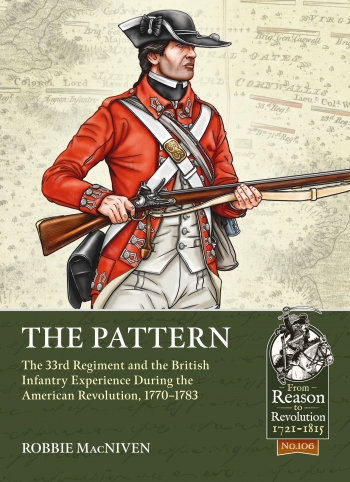THE PATTERN
The 33rd Regiment and the British Infantry Experience During the American Revolution, 1770-1783
Autore: Robbie MacNiven
Codice: 283377
In the early 1770s, the 33rd Foot acquired a reputation as the best-trained regiment in the British Army. This reputation would be tested beyond breaking point over the course of the American Revolutionary War. From Saratoga to South Carolina, the 33rd was one of the most heavily-engaged units – on either side – throughout the war.
The 33rd’s rise to prominence stemmed from its colonel, Charles, Earl Cornwallis, who took over in 1766. In a period where senior officers wielded huge influence over their own regiments, Cornwallis proved to be the best kind of commander. Diligent and meticulous, he focussed on improving the 33rd in every regard, from drills and field exercises to the quality of the unit’s weapons and clothing.
The 33rd subsequently became known as the ‘pattern’ for the army, the unit on which other successful regiments were based. Prior to the outbreak of fighting in the American colonies in 1775, the 33rd’s abilities, particularly in new light infantry drills, were frequently praised. At one point they even assisted in training the elite regiments of the Foot Guards.
The 33rd missed the first year of the Revolutionary War, but sailed in early 1776 as part of the ill-fated expedition to capture Charleston, in South Carolina. After joining the main British force in North America outside New York in August 1776, the 33rd was brigaded with the best units in the army, including the composite grenadier and light infantry battalions.
Over the next five years the regiment engaged in every major battle of the Revolutionary War, from Long Island and Brandywine to Germantown and Monmouth – it even had one unlucky company of recruits present at Freeman’s Farm and Bemis Heights, and the subsequent surrender at Saratoga. In 1780 ‘The Pattern’ was part of Britain’s southern expedition, which put Cornwallis in command of the Crown’s efforts to subdue the Carolinas. Here the 33rd provided perhaps their greatest service – and fought their most desperate battles – at Camden and Guildford Courthouse. They marched to eventual defeat at Yorktown, but not all of the regiment’s companies were captured, and some continued to serve actively elsewhere right up until the end of the war.
This work is partly a regimental history, giving the most detailed account yet of the 33rd‘s actions during the Revolutionary War. It is also, however, a broader study of the British Army during the revolutionary era. It assesses what a single regiment can tell us about wider issues affecting Britain’s military. Everything from training, weapons and uniforms, organisation, transportation, camp life, discipline, food, finances and the role of women and camp followers is addressed alongside the marching, fighting and dying done by the men of the regiment between 1775 and 1783. Primary sources, particularly engaging accounts such as those of Captain William Dansey or John Robert Shaw, a regular enlisted man, provide an engrossing narrative to this part social, part military history of the British Army at war in the late eighteenth century.
"Robbie MacNiven catalogues the 33rd’s American war with skill, an exhaustive survey of primary sources, and great historical flair." Mark Urban, author of Fusiliers
INGLESE
26 illustrazioni in bianco e nero e 20 a colori, 15 mappe
274
18 x 25


